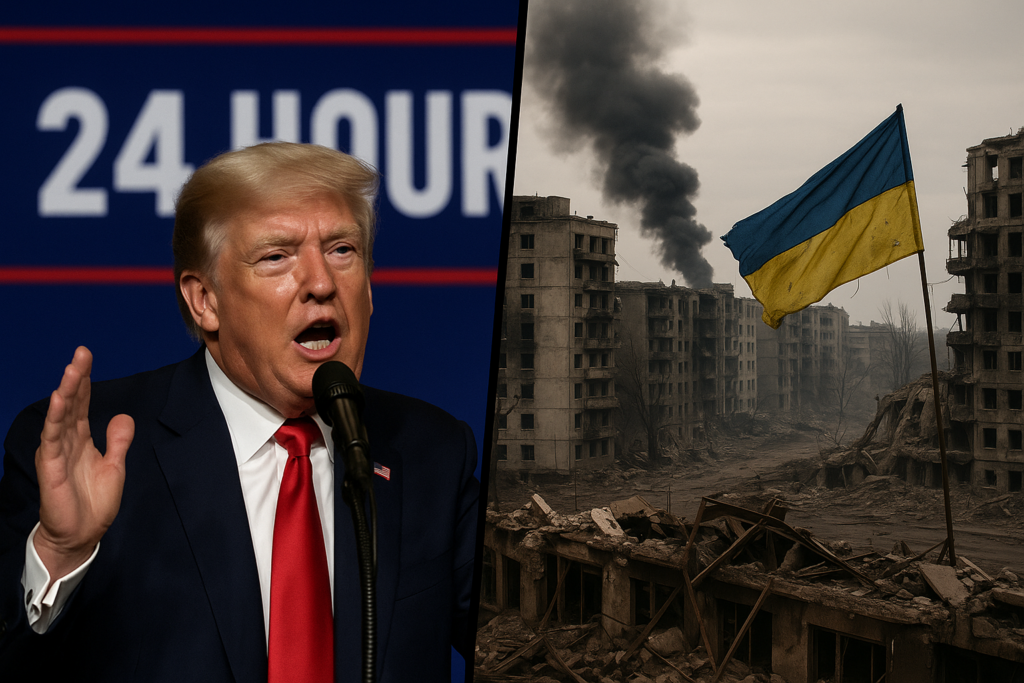
- Trump’s failure lies in his inability to craft a coherent, principled foreign policy that could address Russia’s concerns and Europe’s security needs.
- Trump’s post-presidency claim that he could end the war in 24 hours deserves special scrutiny.
- Rather than being a credible mediator, Trump increasingly became a polarising figure in Europe and Russia.
- Instead of leveraging his initial goodwill with Putin into a serious diplomatic framework, Trump oscillated between aggression and appeasement, ultimately pleasing no one.
Ever since Russia launched its full-scale invasion of Ukraine in February 2022, a persistent narrative has emerged in U.S. conservative circles: that if Donald Trump had been in the White House, the war would never have happened. Trump has often echoed this sentiment, claiming he had the diplomatic prowess to “end the war in 24 hours” (BBC News, 2023). While such rhetoric resonates with his base, the actual geopolitical dynamics tell a more complicated story, filled with missed opportunities, deep-rooted strategic tensions, and a failure to engage both sides constructively.
In this piece, I aim to analyse why Trump, despite his bombastic claims, ultimately failed to stop the war in Ukraine, both during his presidency and in his post-presidency political positioning. I will examine Russia’s long-standing security concerns, Europe’s divided but gradually consolidating stance, and Trump’s contradictory approach to diplomacy and deterrence.
Understanding Russia’s Grievances
To analyse Trump’s failure, it is essential to start with the context in which tensions between Russia and Ukraine escalated. Russia’s invasion in 2022 was not an isolated event. It was the culmination of years of NATO expansion, post-Soviet geopolitical reconfigurations, and Moscow’s increasing paranoia about Western encroachment near its borders.
Vladimir Putin has repeatedly expressed that NATO’s eastward expansion, particularly discussions around Ukraine’s potential membership, represents an existential threat to Russian security (Mearsheimer, 2014). During Trump’s presidency (2017–2021), NATO did not formally expand to include Ukraine, but military cooperation between Kyiv and Western powers increased substantially. The Trump administration approved lethal aid to Ukraine in 2017, including Javelin anti-tank missiles, which was something the Obama administration had been reluctant to do (Sanger & Cooper, 2017).
From a Russian perspective, this move represented an apparent tilt toward militarising the conflict in Donbas, rather than de-escalating it. So, while Trump talked about better relations with Putin, his policy decisions, perhaps guided by the Pentagon and Republican hawks, did little to reassure Moscow.
Europe’s Ambivalence
Another key factor in understanding why the war escalated, and why Trump could not prevent it, is Europe’s evolving stance. European nations, especially Germany and France, initially pushed for diplomatic solutions under frameworks like the Minsk Agreements (2015), but these largely failed due to non-compliance on both sides.
By 2021, NATO allies invested more in military preparedness and less in diplomacy. This shift was partly driven by Russia’s annexation of Crimea in 2014, which shattered the illusion of a post-Cold War peace in Europe. While European leaders publicly expressed interest in peace, the arms industry and strategic calculus were increasingly prepared for the opposite.
As journalist Seymour Hersh reported in 2023, the Nord Stream sabotage and expanded U.S. military aid reflect deeper interests in keeping Russia economically and militarily constrained (Hersh, 2023). In this context, Trump’s repeated expressions of admiration for Putin alienated European partners, who saw them as undermining transatlantic unity.
Trump’s Contradictory Diplomacy
Trump’s supporters argue that his unpredictability served as a deterrent against Putin. No full-scale invasion indeed occurred during his term. However, correlation is not causation. More telling is that Trump’s foreign policy was riddled with contradictions.
For instance, he frequently lambasted NATO allies for not spending enough on defence (Bennhold, 2018), threatening to weaken the alliance that served as a deterrent force. At the same time, he praised authoritarian leaders like Putin and Kim Jong-un while undermining U.S. intelligence assessments, as seen in the Helsinki Summit of 2018, where he sided with Putin over his intelligence agencies on election interference (Rosenberg, 2018).
Rather than being a credible mediator, Trump increasingly became a polarising figure in Europe and Russia. His disengagement from traditional diplomacy and his transactional worldview meant that even if he had proposed a peace deal between Russia and Ukraine, it would likely have lacked legitimacy in the eyes of key stakeholders.
The 24-Hour Claim
Trump’s post-presidency claim that he could end the war in 24 hours deserves special scrutiny. In my view, this is not only unrealistic, it is dangerously simplistic. The Ukraine war is a complex, deeply entrenched conflict involving sovereignty, identity, territorial control, and great-power rivalry.
Ending the war would require significant compromises from Kyiv and Moscow, something neither side has shown a willingness to do. Would Trump have asked Ukraine to surrender territory to appease Putin? If so, how would that have affected U.S. credibility and alliances globally? Moreover, would Russia have even trusted a deal brokered by a leader who was no longer in power and subject to a volatile domestic political environment?
Moreover, Trump’s record shows no successful precedent for resolving active military conflicts. He did not end the war in Afghanistan (Biden’s administration completed that withdrawal in 2021), and his peace talks with North Korea ultimately yielded no denuclearisation.
Conclusion
To be fair, Trump inherited a complex situation. The groundwork for the Ukraine war was laid long before he entered office, and multiple U.S. administrations, both Democrat and Republican, ignored or underestimated Russian red lines. However, Trump’s failure lies in his inability to craft a coherent, principled foreign policy that could address Russia’s concerns and Europe’s security needs.
Instead of leveraging his initial goodwill with Putin into a serious diplomatic framework, Trump oscillated between aggression and appeasement, ultimately pleasing no one. His transactional style, disdain for traditional alliances, and lack of strategic patience left the U.S. and the world less prepared for what would come in 2022.
Thus, when Trump says he could have stopped the war, it is worth remembering that peace requires more than strongman posturing; it requires diplomacy, consistency, and a deep understanding of historical grievances. Unfortunately, those were not qualities that defined Trump’s foreign policy.
References:
- BBC News. (2023, March 29). Trump says he could end the Ukraine war in 24 hours.
- Bennhold, K. (2018, July 11). Trump’s NATO tirade leaves allies shaken but determined, The New York Times.
- Hersh, S. (2023, February 8). How America took out the Nord Stream pipeline.
- Mearsheimer, J. J. (2014). Why the Ukraine crisis is the West’s fault. Foreign Affairs, 93(5), 77–89.
- Rosenberg, M. (2018, July 16). Trump, at Putin’s side, questions U.S. intelligence on 2016 election, The New York Times.
- Sanger, D. E., & Cooper, H. (2017, March 1). The Trump administration approves arms for Ukraine, reversing Obama’s policy, The New York Times.
Sakshi Yadav is pursuing a Master’s Degree in International Studies from Christ University, Bangalore. Her research areas include International Political Economy, South Asia, South Pacific and U.S. Foreign Policy. Views expressed are the author’s own.
